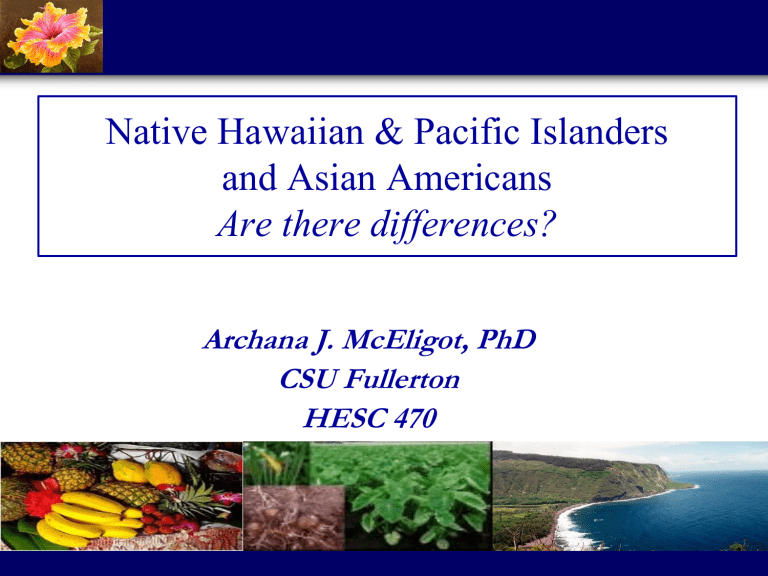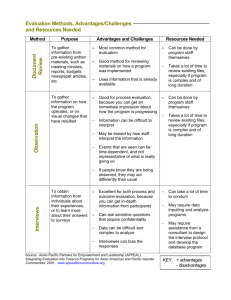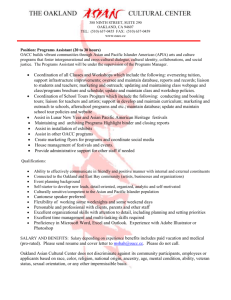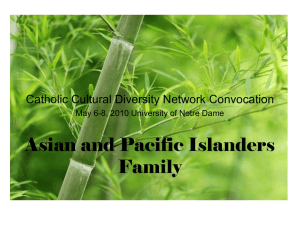Are there differences? - Nutrition For A Changing World

Native Hawaiian & Pacific Islanders and Asian Americans
Are there differences?
Archana J. McEligot, PhD
CSU Fullerton
HESC 470
Objectives
1. Provide data on AA & NHPI diversity
2. Distinguish groups geographically and culturally a. Asian Americans b. NHPI
3. Present brief history of NHPI
4. Outline population changes in US
5. Discuss obesity trends between groups
6. Provide data on health disparities
7. Activity
Hafa
Bula (Ni sa bula vi naka)
Yokwe yuk
Aloha
Alii
Malo
som pas
sa-bai-dee
chao
Ia ora na
'outou
Malo e lelei
Hello
Selamat pagi
Selamat sore
Selamat siang
Selamat malam
Selamat tidur
Diversity in AA and NHPI
• ~30 distinct Asian ethnic and cultural groups 1
• 60% of Asians in U.S. are foreign born in 2009 2
•
~50 distinct Native Hawaiian and Pacific Islander ethnic and cultural groups 1
•
12% of NHPIs in U.S. are foreign born in 2009 2
•
>2,000 distinct Asian and Pacific languages and dialects 3
•
>100 Asian or Pacific Island languages/dialects commonly spoken in the U.S.
4
1 U.S. Census: The Native Hawaiian and Other Pacific Islander Population: 2000, Census 2000 Brief, issued December 2001; Asian & Pacific Islander
American Health Forum, 2000. 2 U.S. Census 2009 Estimates. 3 Boeree CG: The Language Families of the World, http://webspace.ship.edu/cgboer/languagefamilies.html
. 4 AAPCHO: Asian Americans, Native Hawaiians and other Pacific Islanders (AA and
NHOPIs), http://www.aapcho.org/site/aapcho/section.php?id=10950 .
Cultural, Diet and other Differences
Asian American NHPI
• Geographically distinct • Geographically distinct
• 1,000’s of different languages • Variation in languages, but not as varied as Asians
• Diet – very varied from India to China to Japan, and
Southeast Asia
• Religion – Eastern religions:
Hinduism, Taoism,
Buddhism,
• Diet – traditional Hawaiian diet is very distinct from the Asian diet
• Cultural differences – family structure and hierarchy
• The role of the child and their duties to family
• Culturally distinct in that NHPI are very social and children are central to the community
• Story-telling is an important tradition
• Religion: Traditional religion of worshiping the land and gods, and also christianity
Objectives
1. Provide data on AA & NHPI diversity
2. Distinguish groups geographically and culturally a. Asian Americans b. NHPI
3. Present brief history of NHPI
4. Outline population changes in US
5. Discuss obesity trends between groups
6. Provide data on health disparities
7. Activity
Asian Americans
ASIANS
Persons “having origins in any of the original peoples of the Far East, Southeast Asia, or the
Indian subcontinent”.
1
FAR EAST
(“ASIA”)
Iwo-Jiman
Japanese
Korean
Chinese
Mongolia
Taiwanese
Tibetan 2,3
SOUTHEAST ASIA
Burmese
Bornean
Laotian
2
Cambodian
Hmong
Indochinese
Indonesian
Javanese
Malayan
Mien
Mongolian
Nepali 2
Filipino / Pilipino
Singaporean
Thai
Vietnamese
INDIAN SUBCONTINENT
(“South Asians”)
Asian Indian
Bangladeshi
Bhutanese
Maldives
Nepali 2
Pakistani
Sri Lankan
Afghanistani 2
Burmese/Myanmar 2
Tibetan 2,3
1 U.S. Census definition. 2 These groups are sometimes included in a broader definition of South Asian or South-east Asian; although they are not always identified as being of “Asian origin”. 3 Although the People’s Republic of China claims sovereignty over the Tibetan people, Tibet maintains its independence as a government-in-exile. Officially, the U.S. government considers Tibet to be part of China. However, Tibet’s exiled spiritual leader, the Dalai Lama, has many supporters in the U.S. and the Congress, and Tibet’s political status remains controversial in the U.S.
Asian American Network for Cancer Awareness, Research & Education, 2000, http://aancart.org/whoareasianamericans.html
; Leadership Education for
Asian Pacifics, Inc. (LEAP), 2000; South Asian Public Health Association (SAPHA), 2002; U.S. Census, 2000 and 2004; U.S. Department of State:
Background Notes: Taiwan, U.S. Relations, Oct 2009, http://www.state.gov/r/pa/ei/bgn/35855.htm#relations .
Asia
Southeast
Asia:
Cambodia
Laos
Thailand
Vietnam
Thailand
Objectives
1. Provide data on AA & NHPI diversity
2. Distinguish groups geographically and culturally a. Asian Americans b. NHPI
3. Present brief history of NHPI
4. Outline population changes in US
5. Discuss obesity trends between groups
6. Provide data on health disparities
7. Activity
Native Hawaiians
NATIVE HAWAIIANS and PACIFIC ISLANDERS
Persons “having origins in any of the original peoples of Hawai`i,
Guam, Samoa, or other Pacific Islands”
POLYNESIAN MICRONESIAN MELANESIAN
Cook Islander
French Polynesian
Maori
Native Hawaiian
Niuean
Samoan
Tongan
Tahitian
Tokelauan
Bikini Islander Marshall Islander
Carolinian Marshallese
Chamorro/Guamanian Palauan
Chuukese/Trukese Pohnpeian /
Enewetak Islander (Ponapean)
I-Kiribati Saipanese
Kosraean Tinian Islander
Kwajalein Islander Yapese
Northern Mariana Islander
Fijian
Nauruan
New Caledonian
Ni-Vanuatu /
Vanuatu Islander
Papuan
Papua New Guinean
Solomon Islander
Tuvaluan
U.S. Census: The Native Hawaiian and Other Pacific Islander Population: 2000, Census 2000 Brief, issued December
2001; Asian & Pacific Islander American Health Forum, 2000
THE PACIFIC
WorldAtlas.com ( http://worldatlas.com/aatlas/infopage/oceans/pacificocean.htm
);
Pacific Resources for Education and Learning ( http://www.prel.org/pacserv/pacserv_top.asp
)
14
Polynesian:
Native Hawaiian, Samoan
Tongan, Tahitian, Tokelauan,
Polynesian not specified.
Micronesian:
Guamanian or Chamorro, Mariana Islander, Saipanese, Palauan,
Carolinian, Kosraean, Pohnpeian, Chuukese, Yapese, Marshallese,
I-Kiribati, Micronesian not-specified.
Melanesian:
Fijian, Ni-Vanuatu, Solomon Islander, Papua New
Guinean, Melanesian not specified (New Caledonia,
Torres Strait Islands).
Objectives
1. Provide data on AA & NHPI diversity
2. Distinguish groups geographically and culturally a. Asian Americans b. NHPI
3. Present brief history of NHPI
4. Outline population changes in US
5. Discuss obesity trends between groups
6. Provide data on health disparities
7. Activity
2-Minute History of Pacific Island People
Ice Age
5000 Yrs. Ago
3500 Yrs. Ago
7 th – 13 th Century
1513 AD
1519 AD
1564 AD
1642 AD
18 th Century
19 th Century
1914 AD
After WWII (1942)
Timeline
Southeast Asian migrants – New Guinea and Melanesia.
Continued to migrate, populated Micronesia
Migration reached Fiji
Polynesia inhabited inc. Hawaii
Spanish Explorer Vasco Nunez de Balboa 1 st European to sight the
Pacific Islands
Portuguese Explorer Ferdinand Magellan 1 st European to sail
Pacific Islands
Mexican Conquistadors led by Miguel Lopez de Legazpi sailed to
Philippines and Mariana Islands
Dutchman Abel Tasman discovered Tasmania and New Zealand
Russians, French, British Explorers arrive in the Pacific, notably
James Cook. He made 3 voyages and studied and mapped the
Pacific Islands extensively.
Occupation of many Islands by various European countries, USA and Japan
Japan occupied much of the Western Pacific.
Many of the Islands became independent.
History Continued
• Believed to be first discovered in the Ice Age, the Pacific Islands of
Melanesia where the first to be inhabited by people.
• The people migrated from
Southeast Asia.
• The Pacific Islands were not as separated as they are today, due to lower sea levels, which allowed the migrants to cross the water in canoes and small boats.
Southeast Asian Heritage
A small group of Melanesian people are thought to have continued exploring, thus linking the islands of the Polynesia and Micronesia regions genetically. All of the native island people in the Pacific have Southeast
Asian heritage.
Polynesians and Micronesians are thought to be genetically linked to
Melanesian ancestors, however this is contradicted by some studies.
Contradict: Disagree with or oppose.
Objectives
1. Provide data on AA & NHPI diversity
2. Distinguish groups geographically and culturally a. Asian Americans b. NHPI
3. Present brief history of NHPI
4. Outline population changes in US
5. Discuss obesity trends between groups
6. Provide data on health disparities
7. Activity
U.S. Census by Race/Ethnicity Inclusive
Population in Thousands, 2000 and 2010
350 000
300 000
250 000
200 000
150 000
100 000
50 000
46%
2000 2010
40%
0
US Total Non-Hispanic
White
Latino /
Hispanic
African Am/
Black
Asian
American
American
Indian/ Alaska
Native
Native
Hawaiian/
Pacific
Islander
U.S. Census 2000 and 2010
25
Objectives
1. Provide data on AA & NHPI diversity
2. Distinguish groups geographically and culturally a. Asian Americans b. NHPI
3. Present brief history of NHPI
4. Outline population changes in US
5. Discuss obesity trends between groups
6. Provide data on health disparities
7. Activity
Overweight and Obesity in Asian American Adults
Overweight in Asian American Children
Physical Activity in Asian American
Overweight and Obesity Levels in NHPI
Physical Activity in NHPI
Objectives
1. Provide data on AA & NHPI diversity
2. Distinguish groups geographically and culturally a. Asian Americans b. NHPI
3. Present brief history of NHPI
4. Outline population changes in US
5. Discuss obesity trends between groups
6. Provide data on health disparities
7. Activity
Health for Asian Americans
•
Health: It is significant to note that Asian American women have the highest life expectancy (85.8 years) of any other ethnic group in the
U.S. Life expectancy varies among Asian subgroups: Filipino (81.5 years), Japanese (84.5 years), and Chinese women (86.1 years) 1 .
• Asian Americans are most at risk for the following health conditions: cancer, heart disease, stroke, unintentional injuries (accidents), and diabetes. Asian Americans also have a high prevalence of the following conditions and risk factors: chronic obstructive pulmonary disease, hepatitis B, HIV/AIDS, smoking, tuberculosis, and liver disease.
• Other Health Concerns: In 2010, tuberculosis was 11 times more common among Asians, with a case rate of 22.2 as compared to 2.0 for the White population.
• Source: Office of Minority Health
Health for Native Hawaiians
•
It is significant to note that in comparison to other ethnic groups, Native
Hawaiians/ Pacific Islanders have higher rates of smoking, alcohol consumption, and obesity.
•
This group also has little access to cancer prevention and control programs.
•
Some leading causes of death among Native Hawaiians/Pacific Islanders include: cancer, heart disease, unintentional injuries (accidents), stroke and diabetes.
• Some other health conditions and risk factors that are prevalent among Native
Hawaiians and Pacific Islanders are hepatitis B, HIV/AIDS, and tuberculosis.
•
The infant mortality rate (deaths per 1,000 live births) for Native Hawaiians in
2002 was 9.6, higher than the rate for all Asian-American/Pacific Islander groups combined (4.8) and for all population (7.0).
• The tuberculosis rate (cases per 100,000) in 2010 was 8 times higher for
Native Hawaiian/Pacific Islanders, with a case rate of 16.6, as compared to 2.0 for the White population.
•
Source: The Office of Minority Health
Diabetes in NHPI
Other Health Disparities in NHPI
Cancer Incidence and Survival
Social Determinants of Health Disparities
• Social Economic Status – how does this relate to health and childhood obesity?
• Food security and insecurity
• Immigration/acculturation issues
• Neighborhood characteristics
Objectives
1. Provide data on AA & NHPI diversity
2. Distinguish groups geographically and culturally a. Asian Americans b. NHPI
3. Present brief history of NHPI
4. Outline population changes in US
5. Discuss obesity trends between groups
6. Provide data on health disparities
7. Activity
Activity
In groups of four – discuss and answer the following questions:
1. Are AA and NHPI different?
2. Discuss the differences –
3. Why are these differences important in terms of addressing health and in addressing childhood obesity?
Acknowledgements/References
• Mavis Nitta, MPH, CHES
• The Office of Minority Health
• Centers for Disease Control
• Dr. Tu-Uyen Nguyen
• Slideshare







